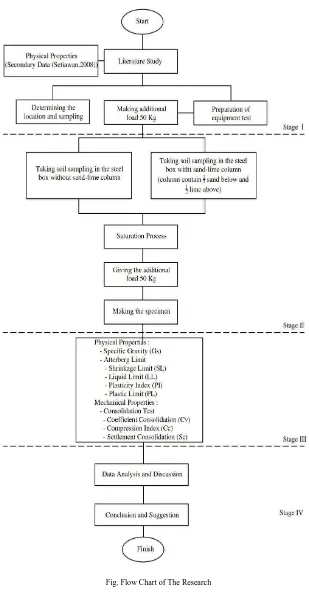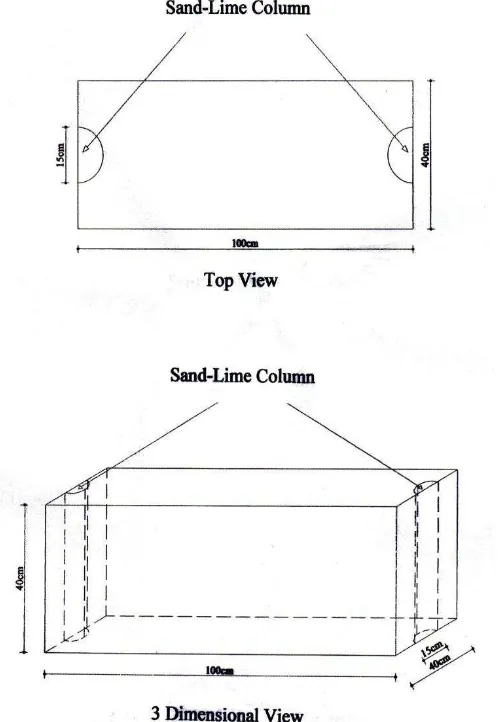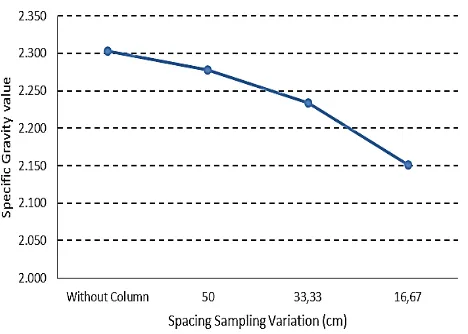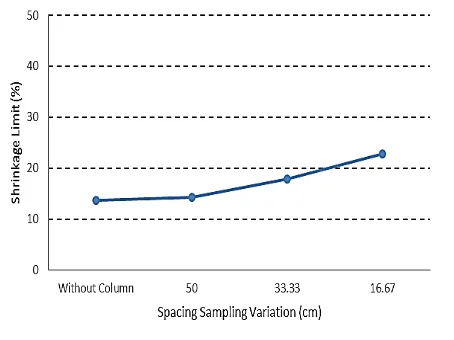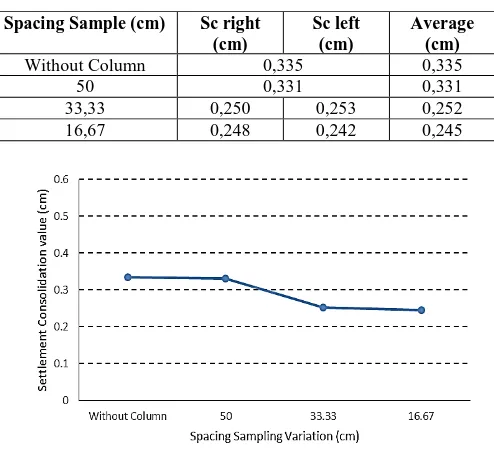The Influence of Sand-Lime Column Toward
Physical Properties and Consolidation Parameter of
Soft Clays
Agus Susanto
#, Anto Budi Listyawan
#, Renaningsih
#, Puguh Merdhiyanto
##
Civil Engineering Department, Muhammadiyah University of Surakarta
Jl. A. Yani Tromol Pos 1 Pabelan Kartasura Telp. (0271) 717417 – 719483 Surakarta
1
Abstract— The construction works sometimes deal with difficult soil, for example soft clay and organic soil. Many kinds of soft clay can be found in Central Java area including Blora, Purwodadi, Sragen, and Klaten. It exposes a problem when building on soft clay sites. Many construction activities are focused on the behavior of the soil, especially when soil different conditions in each area of construction that requires the accuracy of the planning and the execution of construction itself.There are several techniques used to improve the quality of difficult soil, among which are adding stabilizator materials (for example lime) and making the vertical drain. This research aims to determine the influence of sand-lime column stabilization on soft clay soil from Troketon Pedan Klaten in terms of the physical properties, coefficient of consolidation (Cv), compression index (Cc), and the consolidation settlement (Sc) by conducting several testing according to ASTM standard. Spacing sampling variation is 50 cm; 33.33 cm and 16.67 cm from sand-lime column. The result of physical property test shows that the closer soil sample from the sand-lime column, liquid limit (LL) decreased and the plastic limit (PL) and shrinkage limit (SL) increased.Similarly, the closer soil sample from the sand-lime column, plasticity index (PI) decreased. Consolidation test results show, the closer soil sample from the sand-lime column Cv value tends to increase, the highest average Cv values, 0.00177���/second, occur in soil samples which located16.67 cm from sand-lime column. While the value of compression index (Cc) tends to decrease, the smallest Cc value, 0.655, occured in the soil samples which spacing sampling 16.67 cm from sand-lime column. While settlement consolidation (Sc) decreases, the smallest Sc value, 0.245 cm, occured in soil samples which spacing sampling 16.67 cm from sand-lime column.This study shows that the addition of sand-lime column can increase/improve the physical properties and consolidation parameter of soft clay from Troketon Pedan Klaten.
Keywords
—
Coefficient of Consolidation, Compression Index, Consolidation Settlement,Physical Properties, Sand-lime Column, Soft Clay.I. INTRODUCTION
A. Background
The construction works sometimes deal with difficult soil, for example soft clay and peat soil. Many kinds of soft clay, can be found in Central Java area including Blora, Purwodadi, Sragen, and Klaten. It exposes a problem when building on soft clay sites. Many construction activities are focused on the
behavior of the soil, especially when soil different conditions in each area of construction that requires the accuracy of the planning and the execution of construction itself.To overcome the soil conditions, there are several techniques used to improve the quality of soil, among which are adding stabilizator materials (for example lime) and making the vertical drain.
In general, lime is used in many projects for soil stabilization. Lime as a stabilizing agent typically used slaked lime or calcium hydroxide (Ca(OH)2).This method is used in varieties of projects such as on transportation projects and runway projects.
Vertical drain is basically intended to improve the shear strength of the soil, reducing the compressibility of the soil, and preventing a high settlement which possible damage to the building structure. Vertical drain is generally used on soils with low bearing capacity like the soft clay and organic soil. The soil type typically has the following characteristics: extreme moisture content, high compressibility and little permeability coefficients. In principle, the techniqueof vertical drains is done by reducing the water content in the soil (dewatering).
Based on these problems, this research tries to study the influence ofsand-lime column stabilisation onthe physical properties and the consolidation parameterof soft clay soil.In this research soil samples were soft clay soil from Troketon Pedan Klaten and sands were taken from Kaliworo Klaten. The lime which was used was slaked lime from a building material store in Kartasura.
Similar research was previously conducted by Muntohar (2010) with the title “A Laboratory Test on The Strength and Load-Settlement Characteristic of Soft Soils Using Lime Column”. This research only used lime and showed that lime column contributed to enhance the soil strength.
B. Problem Formulation
Based on the background of the problems, the problem formulations of this study include :
1) What is the influence of sand-lime column to the physical properties and consolidation parameter of soft clay?
2) How large is the consolidation parameter and physical properties of soft claywith sand-lime column? C. Research Objective
1) To determine the the influence of sand-lime column to the physical properties and consolidation parameter of soft clay.
2) To determine the value of the consolidation parameter and physical properties of soft claywith sand-lime column. with weihtgof water volume (γw)(Hardiyatmo, 1994).
Basically, the soil has three limitations including liquid limit (LL), plastic limit (PL), and shrinkage limit (SL). However, the plasticity index (PI) of a soil is determined only from the difference of the liquid limit and plastic limit (Plasticity index = Liquid limit-Plastic limit).
Plastic limit (PL) is determined by rolling out a thread of the fine portion of a soil on a flat, non-porous surface. If the soil is at a moisture content where its behavior is plastic, this thread will retain its shape down to a very narrow diameter. The sample can then be remoulded and the test is repeated. As the moisture content falls due to evaporation, the thread will begin to break apart at larger diameters.
Liquid limit (LL) is conceptually defined as the water content at which the behavior of a clayey soil changes from plastic to liquid. However, the transition from plastic to liquid behavior is gradual over a range of water contents, and the shear strength of the soil is not actually zero at the liquid limit.
Plasticity index (PI) is a measure of the plasticity of a soil. The plasticity index is the size of the range of water contents where the soil exhibits plastic properties. The PI is the difference between the liquid limit and the plastic limit (PI = LL-PL). Soils with a high PI tend to be clay, those with a lower PI tend to be silt, and those with a PI of 0 (non-plastic) tend to have little or no silt or clay.
Shrinkage limit (SL) is the water content where further loss of moisture will not result in any more volume reduction. The shrinkage limit is much less commonly used than the liquid and plastic limits.
2) Soil Consolidation
A layer of soil experiencing additional load on it, the pore water will come out of the pores, so that the contents (volume) of soil will shrink. Consolidation generally lasts only one direction, namely vertical direction, because of the load addition cannot move the soil in a horizontal direction
In the clay layer, the settlement is running a bit slow (takes a long time), but high. Therefore, research consolidation is generally conducted only on clay soil (fine grain). Because clay has the properties of "high compressibility".
A process of consolidation typically has a long enough time span even 50 years or more. This situation will show the ability of the soil condenses or so-called index compression. Consolidation parameter consist of Coefficient of Consolidation (Cv) and Compressibility Index (Cc).
Coefficient of Consolidation (Cv) is used to estimate the speed of soil settlement. Because the speed will greatly affect the condition of the building structures that stand above it, it is very important to know it, especially for soil having a very
Cv = Coefficient of Consolidation (� 2/second)
H = high of soil (cm)
Compressibility Index (Cc)is the slope of the straight part of the graph of e-log p' consolidation in the results of laboratory test that can be written in equation:
��=∆log∆� ′=
(�1− �2) log ′2− � ′1
Where :
p’1 : effective stress on the soil compressible before loaded (kg/� 2)
p’2 : effective stress on the soil compressible after loaded (kg/� 2)
e1 : large of void ratio on the stress p’1 e2 : large of void ratio on the stress p’2 Cc : Compressibility Index
If the cohesive soil (clay) receives an additional load, it will make consolidation occur. Consolidation rate will be affected by the amount of permeability and the thickness of the soil. The amount of settlement consolidation (Sc)can be formulated as follows:
Cc : Compressibility index H : Thickness of soil layer (cm)
p’1: effective stress on the soil compressible before loaded (kg/� 2)
II. RESEARCH METHOD
In general, the research was conducted in five stages, as described flow chart Fig. 1.
The explanation of flowchart in Fig. 1 1. Stage I
The first step is the determination of the location and soil sampling besides preparing steel plate box 100 x 40 x 40 cm and make a load weighing 50 kg.
2. Stage II Then soil was saturated by soaking water for 4 days. After soil in saturated condition, water was discharged by opening the drain. After waiting for 24 hours, the heap with a weight of 50 kg was placed for 4 days then two samples for testing consolidation were taken.
To prepare soil sample for soft clay consolidation of sand-lime column in the first stage the sand 5 cm height was insertedat the base of the box as horizontal drainage and molding sand-limestone columns in the form of a semi-circle is placed on the edge of the right and left of the box testing. Then, soil sample was inserted until soil reached a height of 30 cm solid and gradually 3 layers with 25 strokes per layer. After the samples were saturated with water soaking for 4 days water was discharged by opening the drain for 24 hours.
Furthermore, mold sand-lime column was removed and the hole was filled with sand ½ of height of soil sample, then placed on it a multiplex separator.Lime was filled in the hole at the top of separator ½ the height of soil sample. Then the sand above the soil samples with a thickness of 5 cm was inserted as a horizontal drainage. After that the heap with a weight of 50 kg was placed and was waited for 4 days.
After removing the heap with a weight of 50 kg, 5 samplesweretaken, namely; 5 samples with a distance of 16.67 cm, 33.37 cm, and 50 cm from the right and left edges of the box test for consolidation testing (ASTM D2435-04).
3. Stage III
On this stage the consolidation test and physical properties test of the soft clay were conducted with and without sand-lime column. Physical properties test consist of specific gravity test (ASTM D854) and Atterberg limits test (ASTM D4318).
4. StageIV
At this stage, the analysis of the data of the tests performed on stage I to stage II. Data analysis was conducted to obtain the conclusion of the research that has been done.
The research equipments are: 1. Steel plate box 100 x 40 x 40 cm 2. The equipment of specific grafity test 3. The equipment of Atterberg Limits test 4. The equipment of consolidation test.
Fig. 2 Steel plate box 100x40x40 cm
III.RESULTS AND ANALYSIS
A. Physical Properties
1) Specific Gravity Test (Gs)
Fig. 3 Relationship between spacing sampling variation and specific gravity (ASTM D854)
Table I and Fig. 3 indicate that the average Specific Gravity of soils decreased starting from: without column;50 cm; 33.33 cm; and 16.67 cm from column. Due to the reaction of cementation between grains of soil and lime, the grains become bigger. Beside that specific gravity of lime are 2.107 less than specific gravity of soil, itmakes the specific gravity of soil closer from the sand-lime column decreased.
2) Atterberg Limits Test
Atterberg Limit test is intended to determine physical properties changes from each sample of soil without stabilization and sand-lime stabilization installed with spacing as in Table II.
TABLEII
RESULT OF ATTERBERG LIMITS TEST
Fig. 4 Relationship between spacing sampling variation and liquid limit value (ASTM D4318)
Table II and Fig. 4 show that liquid limit value (LL) decreased when getting closer to the sand-lime column. This is due to the reaction of cementation between grains of soil and lime, the grain become bigger. Itmakes the soil cohesion decreasedso that the liquid limit value decreased too.
Fig. 5 Relationship between spacing sampling variation and plastic limit value (ASTM D4318)
Fig.. 6 Relationship between spacing sampling variation and plasticity index value (ASTM D4318)
The decrease of liquid limit (LL) and the increase of plastic limit (PL) make plasticity index (PI) decrease. Table II and Fig. 6 showthat the plasticity index value decreased when getting closer to the sand-lime column.The decrease of plasticity index value indicates the decrease of potential expansion of the soil.
Fig. 7 Relationship between spacing sampling variation and shrinkage limit value (ASTM D4943)
When the soil loses moisture content, it will have depreciation until in a position solid or semi-solid and called Shrinkage Limit (SL). Table I and Fig. 7 indicate that the shrinkage limit value (SL) increased when samples taken closer sand-lime columns that mean less the potential of expansion. This is due to the reaction that makes the soil with lime soil grains become larger and reduce the specific surface area of soil and cause soil sensitivity reduce water absorption.
3) Consolidation Test
Consolidation test includes soil without sand-lime column and also soil stabilization with sand-lime column use spacing sampling variation from the right and left of the column as 16.67 cm; 33.33 cm; 50 cm. Test results can be viewed in Table III, Table IV, and Table V.
TABLEIII
COEFFICIENT OF CONSOLIDATION (CV)
Spacing Sample (cm) Cv right (cm)
Cv left (cm)
Average (cm) Without Column 0,00022 0,00022
50 0,00025 0,00025
33,33 0,00138 0,00115 0,00127 16,67 0,00181 0,00172 0,00177
Fig. 8 Relationship between spacing sampling variation and coefficient of consolidation (ASTM D2435-04)
Table IIIand Fig. 8 show the comparison coefficient of consolidation (Cv) among spacing sampling variation. If taking the sample from the column is closer, coefficient consolidation (Cv) increased as well. The higher Cv value, the faster consolidation process. This is due to soil that closer sand-lime column is drier.
TABLEIV
COMPRESSION INDEX VALUE (CC)
Spacing Sample (cm) Cc right (cm)
Cc left (cm)
Average (cm)
Without Column 0,899 0,899
50 0,874 0,874
Fig. 9 Relationship between spacing sampling variation and compression index (ASTM D2435-04)
Table IV and Fig. 9 indicate that compression index value decreased when getting closer to the sand-lime column. Due to the decreaseof soil compression, the compression index decreased too.
TABLEV
SETTLEMENT CONSOLIDATION (SC)
Spacing Sample (cm) Sc right (cm)
Sc left (cm)
Average (cm)
Without Column 0,335 0,335
50 0,331 0,331
33,33 0,250 0,253 0,252 16,67 0,248 0,242 0,245
Fig. 10 Relationship between spacing sampling variation and settlement consolidation (ASTM D2435-04)
Table V and Fig. 10 show that the settlement consolidation value decreased when getting closer to the sand-lime column. The decrease of Sc value shows that sand-lime column has a good effect because it can reduce the settlement.
IV.CONCLUSIONS
Sand-lime column could improve the physical properties of soilfrom Troketon Pedan Klaten. Soil samples were taken 50 cm ; 33.33 cm ; and 16.67 cm from the column have smaller specific gravity (Gs) there 2.277 ; 2.234 ; 2.151 than without sand-lime column 2.303.The value of Liquid limit (LL) decreased, 79.5%; 76.25%; 74.88% are better than without column 82%. Plastic limit (PL) has increasing values, 36.07%; 37.64%; 41.61% are better than without column31.8%. Plasticity index (PI) has decreasing value, 43.43%; 38.62%; 33.27% than without column 50.20%. Shrinkage Limit (SL) has increasing values; 14.26%; 17.84%; 22.74% are better than without column 13.67%.
Consolidation test results show, the closer soil sample from the sand-lime column Cv value tends to increase, the highest average Cv values, 0.00177 � 2/second, occur in soil samples which located 16.67 cm from sand-lime column. While the value of compression index (Cc) tends to decrease, the smallest Cc value, 0.655, occured in the soil samples which spacing sampling 16.67 cm from sand-lime column. While settlement consolidation (Sc) decreases, the smallest Sc value, 0.245 cm, occured in soil samples which spacing sampling 16.67 cm from sand-lime column. This study shows that the addition of sand-lime column can improve the physical properties and consolidation parameter of soft clay from Troketon Pedan Klaten.Sand-lime column is potentially to improve physical and mechanical properties of soft soil in the site because the implementation is easy and cost less than
[2] ASTM D2435-04, Standard Test Methods for One-Dimensional
Consolidation of Soils, ASTM International, West Conshocken, PA, 2005.
[3] ASTM D854, Standard Test Methods for Specific Gravity of Soils,
ASTM International, West Conshocken, PA, 2005.
[4] ASTM D4943, Standard Test Methods for Shrinkage Limit of Soils,
ASTM International, West Conshocken, PA, 2005.
[5] Hardiyatmo, H. C, Mekanika Tanah I, PT. Gramedia Pustaka Utama,
Jakarta, 1994.
[6] Muntohar, A.S, A Laboratory Test on The Strength and
Load-Settlement Characteristic of Soft Soils Using Lime Column, Jurnal Dinamika Teknik Sipil Universitas Muhammadiyah Surakarta, Vol. 10, No. 3, 2010.
[7] Setiawan, A, Pengaruh Pemakaian Kapur Terhadap Tekanan
Pengembangan Dan Penurunan Konsolidasi Pada Tanah Lempung Pedan Klaten, Universitas Muhammadiyah Surakarta, 2008.
[8] Satriyana, MRW, Tinjauan Jarak Pengambilan Sampel Pada Tanah
